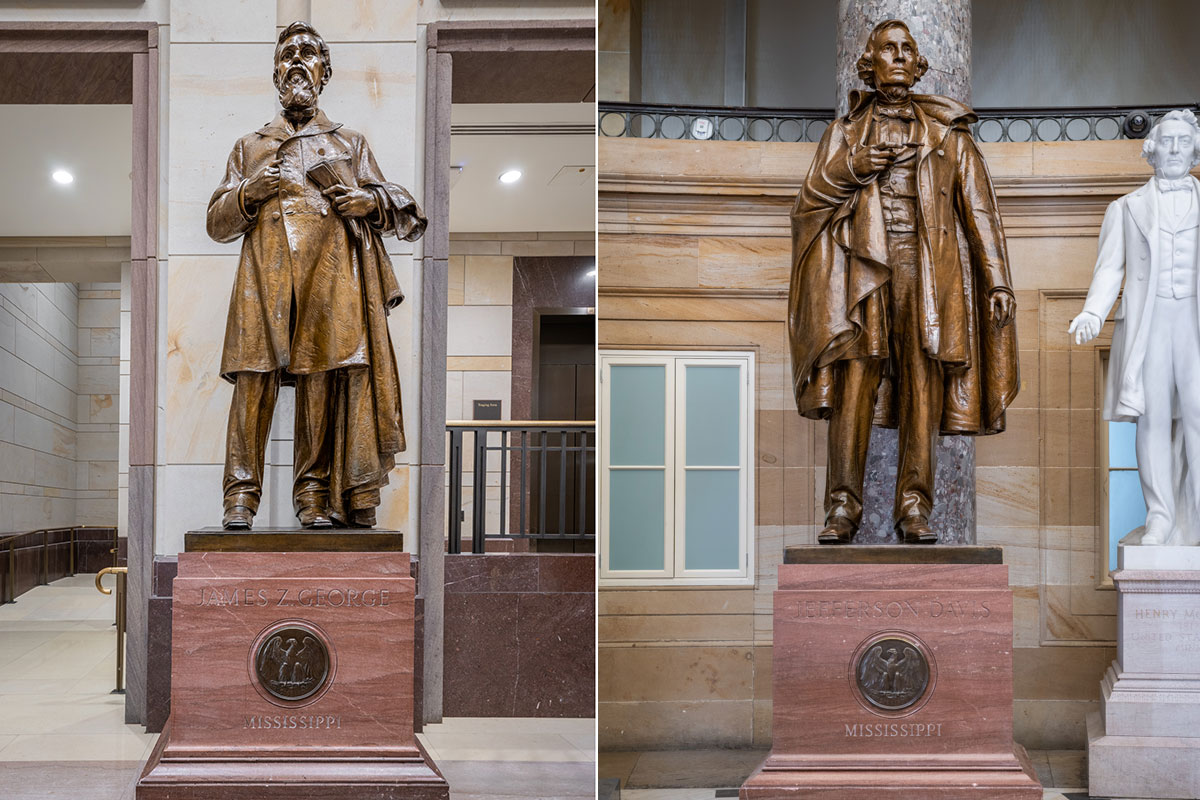Two white-haired generals in uniform raising the Confederate flag remain memorialized in a painting that peers down from the dome of the Mississippi Capitol rotunda even several years after the lawmakers who work beneath its gaze voted to retire the old Confederate-themed state flag. But one young Black lawmaker wants to change that.

“The legislative body determined about three years ago, also due to public pressure, that the flag that has the Confederate emblem in it shouldn’t represent Mississippi,” Sen. Bradford Blackmon, D-Canton, told the Mississippi Free Press on Wednesday.
On Feb. 2, he introduced Senate Bill 2217, which would require the State to remove the painting and set up a commission to recommend a replacement. Blackmon said the replacement should represent all Mississippians.
Mississippi Code § 55-15-81 (2019) prohibits removing or replacing art, monuments or areas in public places that represent previous wars the U.S. was involved in, including the Civil War. S.B. 2217 would amend the code to add that only the Legislature could make an act to authorize repurposing these dedications.
‘Raised to the Top of the Dome’
Sen. Bradford Blackmon’s bill proposes creating a commission including two senators, two state representatives and one member each from the Mississippi Department of Archives and History, the Mississippi Economic Council and the Mississippi Arts Commission. The commission would hold public meetings to determine a replacement for the painting.
“When assessing options for an image to replace the Confederate flag in the Capitol rotunda, give serious consideration to a depiction of the slaves who contributed to the construction of the State Capitol Building,” S.B. 2217 says.

In a follow-up interview with the Mississippi Free Press, Blackmon clarified that he wants the new artwork to honor the enslaved people who built the old Capitol buildings in the 1800s as well as the newly freed Black people who constructed the current Capitol building from 1900 to 1903.
“In 1903, I wouldn’t exactly call the African Americans free,” he told the Mississippi Free Press Friday. “But it is referring to the old capitol more so than the new capitol.”
Even after emancipation, the 13th Amendment allowed an exception for slavery “as a punishment for crime.” State officials endeavored to further criminalize and incarcerate free Black men who would then work on prison plantations. The current Capitol was built on the former site of the old state penitentiary.
If S.B. 2217 became law, the commission would have to share its recommendation with the governor and Legislature by Sept. 30, 2024.

Blackmon said he had not noticed the painting until last November or December when the building was undergoing renovations. He said he did a “double take” and asked some people if they had ever noticed the Confederate imagery. Many people did not know of the image and never saw it despite working in the Capitol daily, the senator added.
“I’m not trying to spark some controversy behind it,” Blackmon said. “We said that the flag with (the Confederate symbol) in there shouldn’t be a representation of the state, then I just don’t think the actual battle flag itself being raised to the top of the dome should be in there either.”
S.B. 2217 is in the Rules Committee, chaired by Sen. Dean Kirby, R-Pearl. If it passes out of committee and the Senate votes in approval, then Gov. Tate Reeves would need to sign the bill into law.
Replace White Supremacist Statues
Some Mississippi Democratic lawmakers are also continuing efforts to remove statues of Jim Crow architect James Zachariah George and Confederate President Jefferson Davis that stand in the U.S. Capitol as representations of Mississippi.
Each state’s legislature can choose statues representing iconic state figures to place in the National Statuary Hall Collection in the nation’s Capitol. Five state Democrats introduced House Concurrent Resolution 12 on Jan. 24 to replace Mississippi’s statues of the two slave owners. Mississippi is the only state with two Confederate statues.

One of the resolution’s sponsors, Mississippi House Rep. Daryl Porter, D-Summit, said the statues should be in history museums but not represent the state on a national level.
“With Mississippi still being the only state living in the past with the Confederate monuments in the halls of Congress, we’re trying to catch the state up by having those taken out,” he told the Mississippi Free Press on Thursday.
When slavery ended, George started efforts to write white supremacy into state law by adding Jim Crow provisions into the 1890 Mississippi Constitution, taking away civil-rights victories Black Mississippians had made since the Civil War. The new constitution made it harder for Black Mississippians to vote by adding poll taxes, literacy tests and loss of voting rights for crimes white supremacists believed Black people were more likely to commit; the latter provision remains in the state constitution today.
“It is the manifest intention of this Convention to secure to the State of Mississippi ‘white supremacy,’” the journal of proceedings for the 1890 Constitutional Convention stated.

Five Mississippi representatives introduced H.C.R. 12 on Jan. 24: Jeffrey Harness, D-Fayette; Daryl Porter, D-Summit; Robert Johnson, D-Natchez; John Hines, D-Greenville; and Bryant Clark, D-Pickens. They are petitioning for the removal of the statues and for replicas of civil-rights activist Fannie Lou Hamer and Sen. Hiram Rhodes Revels, the Mississippian who became the first Black person to serve in the U.S. Senate, to replace them.
Starting as a child, Hamer worked as a sharecropper in Sunflower, Miss.; she learned to read and write just before she was forced to drop out of school at age 12 to work in the fields. As an adult, she became a leading figure in the fight for voting rights for Black Mississippians. In 1964, Hamer co-founded the Mississippi Freedom Democratic Party, taking the fight all the way to the Democratic National Convention, and helped organize Freedom Summer to help with African American voter registration in the South.
The Mississippi Legislature elected Revels to serve as a Republican U.S. Senator from 1870 to 1871 during the Reconstruction era. Before that, he served as a Mississippi State senator in 1869 and a Natchez, Miss., alderman in 1868.
“These are individuals who paved the way for Black people like myself to sit in the Chamber,” Porter said.
H.C.R. 12 is in the Senate Rules Committee, chaired by Sen. Fred Shanks, R-Brandon, and the House State Affairs Committee, chaired by Rep. Henry Zuber III, R-Ocean Springs.
The governor does not sign House concurrent resolutions but for H.C.R. 12 to take effect. After passage in both chambers, the Legislature would deliver the bill to the Secretary of State’s office.










